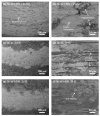High-Temperature Wear Performance of hBN-Added Ni-W Composites Produced from Combustion-Synthesized Powders
- PMID: 35161196
- PMCID: PMC8839063
- DOI: 10.3390/ma15031252
High-Temperature Wear Performance of hBN-Added Ni-W Composites Produced from Combustion-Synthesized Powders
Abstract
This work reports on the spark plasma sintering (SPS) of self-propagating high-temperature-synthesis (SHS)-derived Ni-W and Ni-W-2wt%hBN (4:1 molar ratio of metals) powders. The synthesis was carried out from a mixture of NiO and WO3 using Mg + C combined reducers through a thermo-kinetic coupling approach. Experiments performed in the thermodynamically optimal area demonstrated the high sensitivity of combustion parameters and product phase composition to the amount of reducers and hBN powder. The powder precursors with and without the addition of hBN were consolidated using SPS at a temperature and pressure of 1300 °C and 50 MPa, respectively, followed by a thorough phase and microstructural characterization of the obtained specimens. SHS-derived powders comprised the nano-sized agglomerates and were characterized by a high sinterability. The specimens of >95% density were subjected to ball-on-plate dry sliding wear tests at a sliding speed of 0.1 ms-1 and a distance of 1000 m utilizing an alumina ball of 10 mm in diameter under a 15 N normal load. The tests were performed at a temperature of 800 °C. A significant improvement in wear behavior was demonstrated for SHS-processed composites in comparison with their counterparts produced via conventional high-energy ball milling technique owing to the phenomena of 'micro-polishing', cyclic 'self-healing' and fatigue. However, the decisive effect of hBN addition in imparting lubrication during an HT wear test was not confirmed.
Keywords: Ni-W; friction; hBN; high temperature; self-propagating high-temperature synthesis; sliding wear; spark plasma sintering.
Conflict of interest statement
The authors declare no conflict of interest.
Figures








Similar articles
-
Hot Sliding Wear of 88 wt.% TiB-Ti Composite from SHS Produced Powders.Materials (Basel). 2021 Mar 5;14(5):1242. doi: 10.3390/ma14051242. Materials (Basel). 2021. PMID: 33807973 Free PMC article.
-
SHS-Derived Powders by Reactions' Coupling as Primary Products for Subsequent Consolidation.Materials (Basel). 2021 Sep 6;14(17):5117. doi: 10.3390/ma14175117. Materials (Basel). 2021. PMID: 34501207 Free PMC article. Review.
-
Tribological Characterization of Micron-/Nano-Sized WC-9%Co Cemented Carbides Prepared by Spark Plasma Sintering at Elevated Temperatures.Materials (Basel). 2019 Mar 20;12(6):920. doi: 10.3390/ma12060920. Materials (Basel). 2019. PMID: 30897692 Free PMC article.
-
Tribological Behavior of Carbon-Based Nanomaterial-Reinforced Nickel Metal Matrix Composites.Materials (Basel). 2021 Jun 24;14(13):3536. doi: 10.3390/ma14133536. Materials (Basel). 2021. PMID: 34202854 Free PMC article.
-
Comparison of Reactive and Non-Reactive Spark Plasma Sintering Routes for the Fabrication of Monolithic and Composite Ultra High Temperature Ceramics (UHTC) Materials.Materials (Basel). 2013 Apr 29;6(5):1566-1583. doi: 10.3390/ma6051566. Materials (Basel). 2013. PMID: 28809229 Free PMC article. Review.
Cited by
-
Effect of Laser Surface Texturing and Fabrication Methods on Tribological Properties of Ti6Al4V/HAp Biocomposites.Materials (Basel). 2025 May 24;18(11):2468. doi: 10.3390/ma18112468. Materials (Basel). 2025. PMID: 40508466 Free PMC article.
-
Bioinspired and Multifunctional Tribological Materials for Sliding, Erosive, Machining, and Energy-Absorbing Conditions: A Review.Biomimetics (Basel). 2024 Mar 30;9(4):209. doi: 10.3390/biomimetics9040209. Biomimetics (Basel). 2024. PMID: 38667221 Free PMC article. Review.
-
Tribological Properties of Carbon Fabric/Epoxy Composites Filled with FGr@MoS2 Hybrids under Dry Sliding Conditions.Materials (Basel). 2022 Nov 10;15(22):7951. doi: 10.3390/ma15227951. Materials (Basel). 2022. PMID: 36431437 Free PMC article.
-
Solid Lubrication at High-Temperatures-A Review.Materials (Basel). 2022 Feb 24;15(5):1695. doi: 10.3390/ma15051695. Materials (Basel). 2022. PMID: 35268926 Free PMC article. Review.
References
-
- Cardinal M.F., Castro P.A., Baxi J., Liang H., Williams F.J. Characterization and frictional behavior of nanostructured Ni–W–MoS2 composite coatings. Surf. Coat. Technol. 2009;204:85–90. doi: 10.1016/j.surfcoat.2009.06.037. - DOI
-
- Brooman E. Corrosion performance of environmentally acceptable alternatives to cadmium and chromium coatings: Chromium—Part II. Met. Finish. 2000;98:39–45. doi: 10.1016/S0026-0576(00)82740-3. - DOI
-
- Yamasaki T. High-strength nanocrystalline Ni-W alloys produced by electrodeposition and their embrittlement behaviors during grain growth. Scr. Mater. 2001;44:1497–1502. doi: 10.1016/S1359-6462(01)00720-5. - DOI
-
- Ahmed H.M., Seetharaman S. Isothermal dynamic thermal diffusivity studies of the reduction of NiO and NiWO4 precursors by hydrogen. Int. J. Mater. Res. 2011;102:1336–1344. doi: 10.3139/146.110591. - DOI
-
- Valendar H.M., Rezaie H., Samim H., Barati M., Razavizadeh H. Reduction and carburization behavior of NiO-WO3 mixtures by carbon monoxide. Thermochim. Acta. 2014;590:210–218. doi: 10.1016/j.tca.2014.07.003. - DOI
Grants and funding
LinkOut - more resources
Full Text Sources

